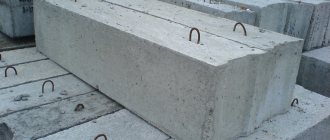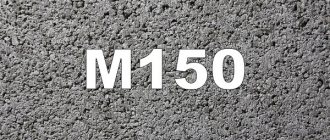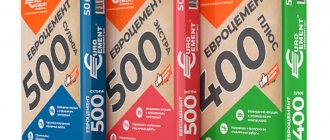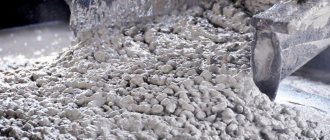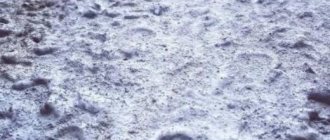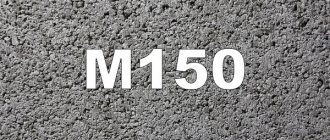In construction, along with ordinary, even durable concrete, reinforced concrete products and structures that have increased strength are used. With all the advantages of this building material, the high density of reinforced concrete provides it with its only drawback - a large mass of products. In addition, the weight of the products is significantly increased by the reinforcement inside the hardened concrete solution. Therefore, when designing structures using reinforced concrete, it is necessary to take into account this feature, setting broader strength criteria for accompanying structures.
State of density of building materials in comparison with reinforced concrete
Requirements according to exposure classes
More detailed information can be found in specification B 1 “Cement and its production”.
According to the German Reinforced Concrete Committee directive "Massive structures made of concrete", different requirements apply for massive structures (minimum structure size > 80 cm). In the case where structures comply with several exposure classes, the highest requirements for concrete properties are important, for example the minimum required water-cement ratio and the minimum cement content. For reinforced external structures made of monolithic concrete (e.g. outdoor stairwells) exposed to defrosting salts, this means, for example, that in accordance with exposure classes XC4, XF4 and XD3 the limit value of the equivalent water-cement ratio is < 0.45, and in addition This requires a minimum cement content of > 320 kg/m and an ultimate compressive strength class of C30/37. 1 Destruction of concrete under the influence of frost To achieve the required workability, a larger amount of water is usually added to the freshly prepared concrete mixture than is required for cement hydration. This excess water subsequently forms a system of pores (capillary pores) in the hardened concrete. When exposed to frost, the water in the pores freezes completely or partially, and the ice formed as a result of freezing puts pressure on the pore walls, which can lead to the destruction of its structure if the concrete mixture is not prepared properly. Read more…
Natural stone materials
Natural stone materials
The properties of natural stone materials are determined, first of all, by the properties of the rock from which they are obtained. The quality of a rock depends on its origin (genesis), mineralogical composition, structure (structure), composition (texture) and degree of weathering. The wide variety of structures and textures of rocks causes the same variety of construction and technical properties of stone materials. The study of these properties is of great importance when assessing rock as a raw material for the production of stone materials, as well as for determining the quality of the stone materials themselves and the degree of their suitability for construction.
The quality of rocks and stone materials made from them used in road and bridge construction is determined by studying:
physical properties
rocks, which include density, bulk density, porosity, humidity, water saturation, frost resistance, cementing ability, thermal conductivity, sound conductivity, etc.;
mechanical properties
— compressive strength, tensile strength, crushing strength, impact load (viscosity), abrasion resistance, wear resistance, etc.;
compliance of the shape , size and quality of processing of stone materials (crushed stone, checkers, paving stones, side and rubble stone) with the specified standards or instructions. The properties of stone materials are determined in laboratories using average samples, as well as from the results of observing the behavior of the material in experimental areas. When studying methods for testing stone materials and their results, you should always keep in mind that they are to some extent arbitrary and cannot always correctly indicate the possible behavior of the material in practice. To objectively study the properties of materials, it is necessary to accurately perform tests, accumulate a large amount of test data, study and analyze this data, and, finally, compare them with the already known practice of the behavior of the material in practice. Imperfection of methods for determining the properties of materials, sloppiness in definitions and fragmentation of indicators lead to erroneous conclusions about the quality of the material. The ability to accurately determine the properties of materials is especially important when using local, little-known stone materials for construction.
Equipment for testing in laboratories during construction, conditions and sequence of tests must strictly meet the requirements of the relevant GOSTs and instructions.
For any laboratory tests, data from preliminary theological, visual determinations of rock samples on site, directly in the field, are very valuable.
According to the rules of geology, with the help of simple devices and reagents (a binocular or simple magnifying glass, a ruler with millimeter divisions, a knife, a steel needle, acids, a blowpipe), one can often determine the minerals that make up a rock, its structure and texture, which is studied in a geology course.
The average sample is taken from a rock deposit or batch of supplied stone material and should represent the average quality of the entire deposit or batch. The procedure and method for collecting average samples is usually indicated in the relevant GOST or instructions.
Physical properties.
According to the unified International System of Units (SI), the old concepts of specific gravity, volumetric gravity, volumetric bulk density are replaced for more precise designation by the concepts of density, bulk density and bulk density, respectively. The SI unit for these quantities is kilogram per cubic meter (kg/m3). Gram per cubic centimeter (g/cm3), ton per cubic meter (t/m3) are used as submultiple and multiple units of measurement in technology. The density (specific gravity) of the original rock is defined as the ratio of the resting mass of the mineral substance without pores and voids to its volume.
To determine the density, a rock sample is crushed and sifted through a 0.15 mm sieve, then dried. When determining density using a pycnometer, two samples weighing 10 g each (t) are weighed from the dried powder for parallel testing. Each sample is poured into a dry pycnometer, filled with water to half the volume of the pycnometer and boiled for 15-20 minutes. Then cool, add water to the mark and weigh (t2). After this, weigh the same pycnometer filled with clean water to the mark (t1). Density is calculated using the formula
When determining density in a volume meter, a sample weighing 80 g (m1) is weighed from the dried powder. Then, powder is poured into a volume meter filled to the bottom line with dehydrated kerosene until the kerosene level rises to the top line, i.e., 20 ml (V). The remainder of the sample is weighed (m2) and the density is calculated using the formula
The density of most stone materials is in the range of 2.7-2.9 g/cm3, and in igneous rocks it is higher than in sedimentary rocks, for example: the density of basalt, diabase, gabbro, diorite reaches 3.2 g/cm3.
Volumetric mass.
Volumetric mass (volumetric weight) is the mass per unit volume of a dried stone with pores in its natural state. The volumetric mass is expressed in grams per cubic centimeter (g/cm3), or in kilograms per cubic meter and is calculated using the formula
p0=m / V
The sample mass m is determined by simple weighing, and the volume V is determined in several ways. With the correct geometric shape of the sample with smooth surfaces, the volume is determined by direct measurement. The volume is most accurately determined by hydrostatic weighing based on the mass of displaced water.
The volumetric mass of a rock is always numerically less than its density, since the mass of a given material in its natural state (with pores) occupies a larger volume than the same mass without pores. For example, the volumetric mass of granite is approximately 2.6 g/cm3, and its density is 2.7 g/cm3; the volumetric mass of Artik tuff is 0.75–1.4 g/cm3, and its density is 2.7–2.8 t/cm3. The bulk density of a rock material depends on porosity and on the mineralogical composition, because different minerals have different densities. Knowledge of the volumetric mass of the material is necessary for calculations during the design and construction of a structure. In road and bridge construction, loose, bulk materials (crushed stone, gravel, sand, various binders) are widely used. When selecting concrete mixtures, during storage, and transportation, it is necessary to know the mass of freshly poured materials. The mass of these materials will be less than the volumetric mass of individual grains and pieces of stone material due to the voids between the individual grains filled with air. Therefore, another concept was introduced - bulk mass.
Bulk mass
(volumetric bulk density) is the mass of bulk material per unit volume together with voids. Bulk mass is expressed in kilograms per cubic meter (kg/m3) or in tons per cubic meter (t/m3) and is calculated using the formula
Mass m is determined by weighing, volume V is determined in a vessel (box) freely filled with bulk material.
Bulk mass is a variable quantity, changing depending on many factors (degree of compaction, humidity, grain shape, etc.). Freely poured crushed stone has a smaller bulk mass than compacted one. Dry sand and slightly moistened sand have different bulk masses. In these cases, the bulk mass is influenced by the voidness of the bulk material. The higher the voidness, the lower the bulk mass.
Porosity and voidness
- this is the property of a stone material - to have gaps between individual particles (grains, crystals, minerals) - pores that are not filled with a given substance. The pores of a dry material contain air or gas, the mass of which is insignificant compared to the mass of the material. Pores are small cells in the rock (up to 2 mm), and the spaces between grains of bulk material or pores in a material larger than 2 mm are called voids (emptiness). Pores are open (communicating) and closed. All porosity is called true or total. Thus, the porosity of a stone material can be judged as the degree to which its mass is filled with air, i.e., pores. Porosity is quantitatively determined by the volume of pores per unit volume of mass of the material. True porosity is calculated using the formula
where p is the density, g/cm3; p0—volumetric mass, g/cm3; Vpore - porosity, %. Porosity and voidness have a great influence on such properties of the stone material as mass, water absorption, thermal conductivity, sound conductivity, frost resistance, strength. Stone material with low porosity (up to 5%) is heavier, more durable, less water-absorbing and more frost-resistant. This is the material most often used in road construction.
Water absorption.
Water absorption is the ability of a rock to absorb water when kept in water for a long time, at normal atmospheric pressure and a temperature of 18-20 ° C.
To determine water absorption, three to six cube-shaped samples with an edge length of about 6 cm are taken, dried to constant weight at a temperature of 105-110 ° C, cooled and weighed (t). Then the samples are immersed in water for 48 hours so that the water layers are 2 cm above the samples. After 48 hours, the samples are removed, wiped with a damp soft cloth and immediately weighed separately (m1). Water absorption is calculated as a percentage by mass Wm or by volume Wvol using the following formulas:
where V is the volume of the sample in a dry state, cm3. Depending on water absorption (as a percentage by weight), stone materials are divided: with very high water absorption - more than 8; with high water absorption - from 3 to 8; with average water absorption - from 1.5 to 3.0; with low water absorption - less than 1.5. The water absorption of various stone materials varies widely, for example, the water absorption of granite is about 0.5%, and Artik tuff is 30-34% by weight. Water absorption allows us to judge the porosity of the stone, its frost resistance, and thermal conductivity. Typically, the water absorption of a material is less than porosity, since water does not penetrate into closed pores, but is retained in large pores. In large-porous materials, water absorption is significantly less than porosity (voidness), for example, the porosity of limestone-shell rock is from 40 to 65%, and water absorption is only 20-30% by volume. Stone materials with water absorption of less than 0.5% are considered frost-resistant and are not subject to frost resistance tests. Water absorption also negatively affects the strength of the stone, as will be discussed below.
Water loss or moisture loss
is a property that characterizes the rate of water removal from a stone (drying), when the elasticity of water vapor in the stone is higher than its elasticity in the external environment. The water yield of different stone materials is different and depends on their structure and environmental conditions. This property is determined in the laboratory by drying water-saturated samples until a constant mass is obtained. The water loss indicator is the time in hours required to dry the sample to constant weight
Frost resistance.
Frost resistance
- the ability of a rock in a water-saturated state to withstand repeated alternating freezing and thawing. When water freezes, it increases in. volume by about 10% and the resulting ice puts pressure on the walls of the material, reduces its strength, and eventually destroys it. In road surfaces, stone material finds itself in particularly difficult conditions. In autumn, it is almost always completely saturated with water, and in winter, too. In the spring it freezes and thaws alternately. At the same time, the material experiences enormous loads from cars passing along the road. All rocks with water absorption above 0.5% are tested for frost resistance. This test is carried out on cubic samples measuring 5x5x5 cm or cylinder-shaped with a height and diameter of 5 cm. The test consists of alternately freezing and thawing water-saturated samples at temperatures of minus 20° and plus 20°. The number of freezing and thawing cycles is assumed to be up to 200 or more, depending on the class of the structure and the operating conditions of the stone material in the structure. The rock is considered to have passed the frost resistance test if no damage in the form of cracks, delamination, rounding of edges and corners is found on the samples. For a breed that has passed the frost resistance test, the degree of strength reduction is determined, which is expressed by the frost resistance coefficient. The frost resistance coefficient Kmrz is calculated using the formula
Where; Rmрз is the compressive strength of a sample subjected to freezing, kgf/cm2; Rc is the compressive strength of a dry sample that has not been frozen, kgf/cm2.
Frost-resistant rocks have a frost resistance coefficient close to unity. For samples that fail the frost resistance test, the weight loss is determined for greater clarity.
Test with sodium sulfate solution
(safety test). The solution of sodium sulfate, which saturates the pores of the stone, crystallizes, increases in volume and creates pressure on the walls of the pores, like frozen water when determining frost resistance. Samples, the same as for determining frost resistance and in the same quantity, dried to constant weight, are dipped into the prepared sodium sulfate solution for 20 hours. Then they are dried for 4 hours, cooled and again dipped in the sodium sulfate solution for 4 hours. Alternately immersing the samples in a saturated solution for 4 hours is performed 5 times, after which the samples are inspected with a magnifying glass, noting any damage that appears. Then the samples are washed with running water until sodium sulfate is completely removed, dried to constant weight, and the weight loss of each sample is determined as a percentage. The arithmetic mean of three determinations for homogeneous rocks and five for heterogeneous rocks is taken as the final result.
Mechanical properties.
The mechanical properties of stone materials are characterized by their strength - the ability to resist the destructive action of external mechanical forces. In road and bridge structures, stone materials are mainly affected by compression forces, impacts, abrasion, etc.
Compressive strength . The compressive strength is determined on rock samples in the form of cubes or cylinders. Cubic samples are made on circular or frame saws. Cylindrical samples are drilled on a machine equipped with a crown filled with carbide or diamonds. The edges of the samples that will be subject to the press load are ground and made parallel on a grinding machine.
Stone materials affected by weathering are porous and, when moistened, reduce their strength, therefore it has been established that the main test of rock compressive strength is testing water-saturated samples. Tests are carried out on hydraulic and mechanical presses with power from 60 to 100 tf
An important condition for correctly determining the mechanical strength of materials is a certain rate and uniformity of pressure build-up on the sample. For example, the rate and uniformity of pressure increase when testing stone material should be within the range of 3-5 kgf/cm2 per 1 s. The compressive strength is calculated using the formula
where Rcom is the compressive strength, kg/cm2; R
— the greatest load at which the sample was destroyed, kgf;
F
is the support area of the sample, cm2.
Along with determining the compressive strength of rock, tensile and shear strength is determined.
Tests are carried out on samples of the correct shape. Tensile strength is determined using a tensile testing machine with a device in the form of a special gripper for cylindrical samples; for shear - in conventional compression presses with a device.
To determine the degree of reduction in the strength of water-saturated stone materials compared to dry ones, a numerical characteristic was introduced in the form of a softening coefficient. Thus, the softening coefficient characterizes the water resistance of the material and is determined by the formula
where Rvl is the compressive strength of the water-saturated sample, kgf/cm2;
Rdry—ultimate compressive strength of a dry sample, kgf/cm2.
Stone materials with a softening coefficient of more than 0.8 are considered water-resistant. With a coefficient of less than 0.8, stone materials cannot be used for the construction of road pavement and structures that will be in water or in wet conditions during operation.
Igneous, dense, finely crystalline rocks have a slight decrease in strength in a water-saturated state, therefore, for stone materials with water absorption up to 0.5%, the softening coefficient and frost resistance coefficient need not be determined. Based on their compressive strength after water absorption, stone materials are divided into grades. Often, the grade of stone material is simply taken as an indicator of compressive strength in kilograms per square centimeter (or in newtons per square meter), For example, grade 1200, grade 500, etc.
Impact resistance.
Impact strength . The property of a stone to collapse under impact load is called brittleness. The fragility of a stone material depends on the mineralogical composition, the nature of adhesion between individual minerals, the cementing substance, its condition, the structure and composition of the rock. The most fragile rocks are quartzite, some sandstones and igneous rocks of glassy structure. Fragility is a negative property of stone material used for road pavement. The inverse of brittleness is called toughness. The higher the viscosity of a stone material, the higher its construction properties. The impact strength of rock is determined using a PM impact tester by successive impacts of steel cylinders on a crushed stone sample.
Abrasion resistance
characterizes the hardness of the stone material. Abrasion strength is determined on an abrasion circle, which is a device the main working part of which is a horizontal cast-iron rotating circle on which abrasion of a cylindrical sample occurs. An indicator of strength during testing is the loss of sample mass in grams per square centimeter of abraded surface per 1000 revolutions of the circle.
Wear strength of rock
— abrasion is determined in a shelf rotating drum.
This definition characterizes the viscosity of the rock used for road stone materials. An indicator of wear strength is the weight loss (in percent) of the sample in the form of crushed stone per 500 drum revolutions. The wear strength indicator when tested in a shelf drum is included in the technical characteristics of rocks.
Get text
Preparation and laying of concrete mixture on construction sites
Therefore, when producing concrete, it is necessary to select the dosing time, or, if this is not possible for technical reasons, when carrying out primary control, pay attention to the time of supply of substances to the mixing plant. If breakers are added after basic mixing, the concrete mixture must be mixed until the breaker is completely dissolved in the mixture and begins to work. In a concrete mixer truck, the mixing time after adding the thinner should be at least 1 minute per m3 of concrete mixture, but not less than 5 minutes. When adding retarders (VZ) to increase the placing time by 3 hours or more, the German Reinforced Concrete Committee directive for concrete with extended placing time applies. 4.
Read more…
Specific gravity table
| Concrete grade | Specific gravity of 1m3 of concrete |
| Concrete M100 | 2494 kg |
| Concrete M200 | 2432 kg |
| Concrete M250 | 2348 kg |
| Concrete M300 | 2389 kg |
| Concrete M350 | 2502 kg |
| Concrete M400 | 2376 kg |
| Concrete M500 | 2298 kg |
Now you know how much a cube of concrete of a particular brand weighs. Just keep in mind that it is possible to achieve exact compliance with the characteristics during its factory production.
We use glue instead of plaster: advice from experienced people
However, the question is often asked on forums: “Can I plaster with tile adhesive?” As a rule, the reason for such a craving for experimentation is banal savings. Firstly, it happens that tile adhesive costs an order of magnitude cheaper than plaster composition from a good manufacturer. And secondly, if you are going to glue ceramic tiles in the bathroom and have already purchased the necessary materials in stock, then plastering the walls with tile adhesive will help solve the problem of unexpected surface irregularities.
Read more…
Volumetric weight table
| Cement brand | Liquid state (t/m³) | Dry condition (t/m³) |
| M100 | 2 366 | 2 180 |
| M150 | 2 360 | 2 181 |
| M200 | 2 362 | 2 182 |
| M300 | 2 358 | 2 183 |
| M400 | 2 350 | 2 170 |
| M500 | 2 355 | 2 180 |
If we compare weight indicators in volumetric and specific ratios, it turns out that volumetrically M200 weighs the same as actual concrete M250.
Concrete for road surfaces
35% by weight crushing with C90/1 Granular fillers TL Gestein-StB Characteristics Bottom layer of concrete Top layer of concrete 0/8; SV, I-III 0/22; SV,I-III IV - VI Granulometric composition Fractions of grain composition / supplied filler according to table. 2 TL Gestein-StB Gf80 for 0/5 GC80/20 for 5/11; 11/22; 22/32 Gf85 for 0/2 GC90/10 for 2/5 GC90/15 for 2/5; 5/8; 8/11; 11/16; 16/22 United fractions of grain composition according to table. 3 TL Gestein-StB GC85/20 and GC90/15 GTNr; GTC20/15; GTC20/17.5 GT15; GT17.5 0/2; 0/4 Tolerances according to table. 4, line 1 or 2 in TL Gestein Proportion of fine-grained fractions Grain composition fraction 0/2 to 0/5 Grain composition fraction 2/4 to 16/32 f3 f1 Grain shape of coarse aggregate SI50 (FI50) SI15 (FI15) SI20 (FI20) Fraction of crushed surfaces - C90/1 1)C100/1 C90/1 C90/3 Grinding resistance - PSV48; PSV532) PSV48 PSV44 Frost resistance and resistance to defrosting salts Decomposition ≤ 8% by weight Organic impurities Fine granular aggregate Coarse granular aggregate Anti-setting and hardening components mLPC0.25 mLPC0.05 To be confirmed Water DIN EN1008 Recycling water is prohibited. Additives to concrete mix DIN EN 934-2; Tolerances When using an air-entraining additive and a thinner or an air-entraining additive and a plasticizer simultaneously, an effectiveness test must be performed; the distance factor L < 0.20 mm and the content of air micropores A300 > 1.5% of the volume of concrete mixture additives DIN 10452 are observed; According to DIN EN 450-1, consideration of cement content and water-cement ratio is not permitted. 1) Regionally tested stone structure grains 2) Concrete with exposed aggregate Table 2.
Read more…
Technical requirements for concrete, ordering, delivery and acceptance of concrete mixture
The manufacturer must draw the consumer's attention to the possible hazards when handling freshly prepared concrete mixture. Ready-mixed concrete belongs to the category of “irritating substances (Xi)”, and in the technical specifications it must be marked accordingly. 3. Delivery and acceptance of concrete Before unloading the concrete mixture, the manufacturer must present the consumer with a specification form for each delivery of concrete, in which the following data must be printed, stamped or written down by hand: - name of the ready-mixed concrete plant - technical specification number - date and time of loading, that is time of first contact of cement with water - license plate of the concrete truck or its name - name of the buyer - designation and location of the construction site - details or references to technical characteristics, for example, list number, order number - quantity of concrete mixture in cubic meters - mark of conformity issued by the construction company supervision, indicating DIN EN 206-1 and DIN 1045-2 - name and designation of the certification laboratory - time of arrival of the concrete batch at the construction site - time of start of unloading - time of end of unloading When adding liquefiers on the construction site, the following information must be written down by hand in the technical specification: - time of adding the thinner - amount of the thinner added - approximate remaining amount in the mixing drum before supplying the thinner In addition, the following information must be entered into the technical specification: For concrete of a given quality: - compressive strength class (if necessary, indicate a period other than 28 days for determining the limit compressive strength) - exposure classes and humidity class - type of use of concrete (unreinforced concrete, reinforced concrete, prestressed concrete) or chloride content class - consistency class or limit value of consistency - limiting characteristics of the concrete mixture, if established - type and strength class of cement - type of additives and concrete admixtures - if necessary, type and amount of fiber fiber - special properties, if necessary - nominal size of the largest aggregate grains - density class or target density of light or heavy concrete - strength development of concrete For concrete of a given composition: - details about the composition mixture, for example, cement content and, if necessary, the type of additives and additives - water-cement ratio or consistency, indicating the class or limit value, as established - the nominal size of the largest aggregate grains (The technical specification specifies data on the properties of the concrete mixture, as well as, for example, exposure class and tensile strength class). For standard concrete: - compressive strength class - exposure classes and moisture class - nominal size of the largest aggregate grains - consistency designation - strength set, if installed For high-strength concrete: - automatic printout of all data, including data for concrete of a given quality or composition Additionally, the following must be indicated: - moisture content of the granular aggregate - amount of liquefier added at the construction site - consistency immediately before and after adding the liquefier for each concrete mixer Only timely checking of the technical specifications before unloading the concrete will ensure that the concrete delivered is actually the concrete ordered. In the construction work log, it is necessary to note for which building element the concrete of each delivery was used (for example, indicate the technical specification number).
Mass of garbage
4.10. FERr(TERr) does not take into account the costs of loading and removing construction waste and materials unsuitable for further use obtained during dismantling of structural elements of buildings and structures and engineering and technological equipment. These costs should be determined based on the current tariffs for the transportation of goods for construction, the mass of waste in tons and the distance of its transportation from the construction site to the landfill site, with costs reflected in local estimates. The volumetric mass of construction waste should be taken as averaged according to the following standards: - when dismantling concrete structures - 2400 kg/m3; — when dismantling reinforced concrete structures — 2500 kg/m3; - when dismantling structures made of brick, stone, beating plaster and facing tiles - 1800 kg/m3; — when dismantling wooden and frame-fill structures — 600 kg/m3;
— when performing other disassembly work (except for work on dismantling metal structures and engineering and technological equipment) — 1200 kg/m3.
Note: - volumetric masses of construction waste from dismantling building structures are given based on their accounting in the dense body of structures;
— the mass of dismantled metal structures and engineering and technological equipment is taken according to design data.
smetdlysmet.ru
Thickness of clinker paving stones
According to the documentation, a road surface with a lower thickness, but not lower than 6 cm, is permitted, since there is sufficient experience with proven regional construction methods. The minimum thickness of paving stones for paving roadways is 60 mm. For heavy loads it is necessary to choose a thickness of 71/80 mm. The thickness of the coating for parking areas, auxiliary facilities and recreational facilities for the movement of passenger cars with light traffic loads, the standard thickness in construction categories V and VI is 8 cm, coating with a lower thickness is allowed, but not lower than 6 cm. Increment or reduction in thickness due to local conditions Line Local conditions 1) ABCD 1. 1 Freezing Zone I ± 0 cm 1. 2 Zone II + 5 cm 1.
Read more…
Heavy concrete for radiation protection
Reinforcing steel All types of reinforcing steel can be used in accordance with DIN 488. Under dynamic loads (impacts, explosions), increased elongation and bending requirements may be increased. 2. Composition of the concrete mixture Content of the bound water (hydrogen) taken into account Currently, there is no generally accepted data on the binding of water in cement stone and aggregates (granular aggregates). Table 4 presents approximate data on the content of taken into account cohesive water (hydrogen) in cement stone under various storage and operating conditions.
Read more…
Checking the results obtained for the use of cement-clay mortars
Thus, by solution output we meant the ratio of the volume of the resulting solution to the volume of sand taken (in a dry and loose state). Through special experiments, it was already established that the yield of solution per unit volume of sand fluctuated relatively little, and this significantly facilitated all kinds of approximate calculations on the consumption of components of solutions of various compositions per unit volume of solution. Thus, for preliminary practical calculations, on average it is quite possible to accept for sandy dense solutions (compositions 1: 1: 6, 1: 1, 5: 8, 1: 3: 12, etc.) the yield coefficient φ = 1 - or Consider that per 1 m3 of solution an average of about 1 m3 of sand of good granulometric composition is consumed.
Read more…

